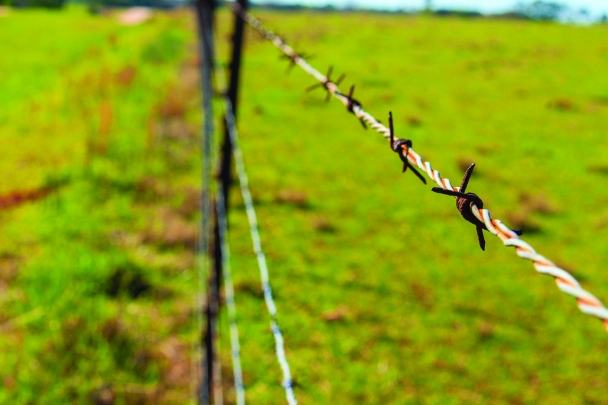PRESERVING THE PAST: Dirt Fences

Before there were barbed wire fences (pictured above), Alpha Owens wrote about dirt fences, provided by the latest Preserving The Past column by Lynne Gentry. [File photo]
I have a goal of driving every road in Calhoun County. I’ll look at the historic spots the members of the historic museum noted in their 1960s tour guides.
Are some of those sites still there?
Another feature of the county that interests me is the presence of fences, or in many cases, the lack of them. Fences, as I knew them growing up are a thing of the past.
Of course, I grew up in the pre-1980s era of small family farms. Each practiced crop rotation meant pasturelands and hay fields. Pasture meant cattle, which needed a fence.
I remember my father stepping on the bottom strand of a barbed wire fence and lifting the second, so there was a wider gap for me to crawl through.
I also remember the woven wire fences topped with several lines of barbed wire. Those inevitably caught pants legs as I crawled over near the fence post.
Sometimes, the barb left a mark. My younger brother still bears the parallel scars of a barbed wire fence he fell into from the feed bunk we were playing on at the time.
Alpha Owens wrote of a kind of fencing I didn’t even know existed. Following is her account of “The Old Dirt Fences.”
“In an early day in the prairie state of Iowa, wood was very scarce. All that grew there was a fringe along the edge of streams. Hence it was impossible to build worm fences or stake and rider fences, as was done in wooded districts. Furthermore, wire for fences was not available. But some kind of fence to keep one’s stock from wandering was needed.
The way that problem was met was by plowing a strip of ground where a fence was needed and to pile up the soil to a height the animals could not jump over.
By the time I came along to Calhoun County, Iowa [recall Owens was born in 1877], those fences were outdated but there was a stretch of one across the end of the lot next to our house. Through the years the dirt had settled until it was probably not more than six feet tall, but to our short legs that seemed quite tall. It was thickly overgrown with wild sunflowers and best of all with sumac.
In the autumn the red berries on the sumac were intriguing. We found we could make a kind of what we called lemonade by soaking them in water. At least it had the virtue of a pretty color and the cream of tartar sort of acid did not taste that bad.
The worst thing about the fence was that it always harbored snakes.
One day one of them crawled up near our house where mother and an older neighbor girl killed it. The snake had found had found there were enemies about and with an instinct of mother love had swallowed her babies.
We counted 28 tiny live snakes that crawled out the mother’s dead body.”
Now I need your help, readers.
Who can tell me what a “worm fence” is? How was a “stake and rider” fence” built?
Alpha Owens lived in Lake City, Rockwell City and on a farm near Lohrville for the first 20 years of her life before moving to Kansas in 1897. Perhaps in the history of a farm, you know there is mention of dirt fences.
I doubt after 140 years, there are any remnants left. You may also have stories of your encounters with fences and snakes.
I’ve been urging you to write these memories down and share them with the museum without telling how!
You can send your stories to Calhoun Country Historical Museum, 150 High Street, P.O. Box 162, Rockwell City, Iowa, 50579. We will happily add them to our archives.
Category:
The Graphic-Advocate
The Graphic-Advocate
121 North Center St.
Lake City, IA 51449
Phone: (641) 456-2585
Mid-America Publishing
This newspaper is part of the Mid-America Publishing Family. Please visit www.midampublishing.com for more information.
